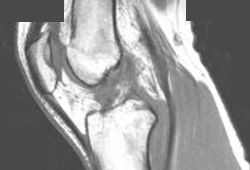Summary
Definition
History and exam
Key diagnostic factors
- audible pop
- rapid knee swelling/effusion
- inability to return to the ongoing sporting activity
- sensation of knee instability or buckling
- pain
- positive anterior drawer test
- positive Lachman test
- positive pivot shift maneuver
Other diagnostic factors
- tenderness at lateral femoral condyle, lateral tibial plateau
Risk factors
- acute trauma
- female sex (after puberty)
- biomechanics
- history of previous anterior cruciate ligament injury
- use of cleats or spikes
- rough or uneven playing surface
- ground condition/weather
- fatigue
- adolescent, young adults, and middle-aged athletes
Diagnostic investigations
1st investigations to order
- x-rays
- MRI
Tests to avoid
- CT
Treatment algorithm
all patients
Contributors
Authors
Philip H. Cohen, MD

Clinical Assistant Professor of Medicine
Robert Wood Johnson Medical School
University of Medicine and Dentistry of New Jersey
Piscataway
NJ
Disclosures
PHC has been reimbursed for travel/lodging costs and has been given a stipend for medical education lectures for MCE Conferences.
Peer reviewers
Richard Ma, MD
Gregory L. and Ann L. Hummel Distinguished Professor
Director - Division of Sports Medicine
University of Missouri School of Medicine
Columbia
MO
Disclosures
RM declares that he has no competing interests.
Matthew A. Tao, MD
Associate Professor
Sports Medicine and Arthroscopic Surgery
University of Nebraska Medical Center
Omaha
NE
Disclosures
MAT has provided consulting services to Vericel and NewClip.
Nicholas A. Trasolini, MD
Assistant Professor of Orthopaedic Surgery
Wake Forest University School of Medicine
Winston-Salem
MO
Disclosures
NAT declares that he has no competing interests.
Jason M. Scopp, MD
Director
Joint Preservation and Sports Medicine Institute
Peninsula Orthopaedic Associates
Salisbury
MD
Disclosures
JMS declares that he has no competing interests.
Jung-Ro Yoon, MD
Director
Department of Orthopedic Surgery
Seoul Veterans Hospital
Seoul
South Korea
Disclosures
JRY declares that she has no competing interests.
Peer reviewer acknowledgements
BMJ Best Practice topics are updated on a rolling basis in line with developments in evidence and guidance. The peer reviewers listed here have reviewed the content at least once during the history of the topic.
Disclosures
Peer reviewer affiliations and disclosures pertain to the time of the review.
References
Key articles
Arundale AJH, Bizzini M, Dix C, et al. Exercise-based knee and anterior cruciate ligament injury prevention. J Orthop Sports Phys Ther. 2023 Jan;53(1):CPG1-34.Full text Abstract
American Academy of Orthopaedic Surgeons. Management of anterior cruciate ligament injuries: evidence-based clinical practice guideline. Aug 2022 [internet publication].Full text
Padua DA, DiStefano LJ, Hewett TE, et al. National Athletic Trainers' Association Position Statement: Prevention of Anterior Cruciate Ligament Injury. J Athl Train. 2018 Jan;53(1):5-19.Full text Abstract
van Melick N, van Cingel RE, Brooijmans F, et al. Evidence-based clinical practice update: practice guidelines for anterior cruciate ligament rehabilitation based on a systematic review and multidisciplinary consensus. Br J Sports Med. 2016 Dec;50(24):1506-15.Full text Abstract
Reference articles
A full list of sources referenced in this topic is available to users with access to all of BMJ Best Practice.

Differentials
- Medial collateral ligament (MCL) sprain
- Posterior collateral ligament (PCL) sprain
- Lateral collateral ligament (LCL) sprain
More DifferentialsGuidelines
- AAOS anterior cruciate ligament injury prevention programs: appropriate use criteria
- Exercise-based knee and anterior cruciate ligament injury prevention
More GuidelinesPatient information
Anterior cruciate ligament injury
More Patient informationLog in or subscribe to access all of BMJ Best Practice
Use of this content is subject to our disclaimer